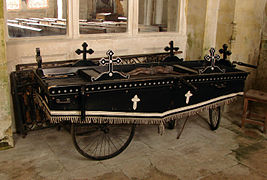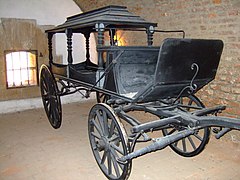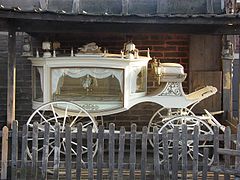Talk:Hearse
| This article is rated Start-class on Wikipedia's content assessment scale. It is of interest to the following WikiProjects: | |||||||||||||||||||||||||||||||
| |||||||||||||||||||||||||||||||
July 2004
[edit]Can one really get a Town Car on an Excursion chassis? I don't see that at the Ford Fleet site; I see you can get a Town Car in a hearse-builder package, or either a Town Car or an Excursion in a limo-builder package, and that's it. —Morven 23:09, Jul 8, 2004 (UTC)
New Zealand
[edit]Love the news story today - register your car as a Hearse and the road tax is $50 instead of $260 - one woman did this, and managed it - her definition of carrying the deceased? Bringing frozen chickens home from the supermarket!
S-shaped bars
[edit]Is there a specific name for the 'large metal S-shaped bars' found on American hearses? Auster1 15:12, 11 January 2007 (UTC)
- Doohicky. Rklawton 16:25, 11 January 2007 (UTC)
- Landau bar(s), named for the type of carriages they used to be found on. The bars were actually part of a folding-top mechanism, but the current ones are purely aesthetic.Improbcat 16:49, 25 January 2007 (UTC)
Hearses in Cultural References
[edit]Hey, I'm not a member, but I was wondering if someone could please add in that an old model Cadillac hearse was used by the Rogues gang in the film "The Warriors". Thanks. —The preceding unsigned comment was added by 124.185.37.81 (talk) 11:29, 17 February 2007 (UTC).
Most Desireable Hearse?
[edit]The 1959 Cadillac Miller Meteor was not the car used in Harold and Maude. That was a 1959 Cadillac Superior. Completely different coach builders. —Preceding unsigned comment added by 128.101.39.243 (talk) 21:41, 24 March 2008 (UTC)
Black ambulances
[edit]In some countries, undertakes use vans which are sign-written as 'Private Ambulance' (often black) to transporting cadavers around. They also frequently have certain traffic and parking exemptions granted them. Does anybody here have inside knowledge; as this type of vehicles has fallen between the gap of 'hearse' proper and 'ambulance' proper. --Aspro (talk) 10:44, 1 April 2008 (UTC)
- These are combination cars. Some funeral businesses run ambulance businesses on the side. This is common in Europe, and the funeral coaches employed are of the American type, with landau bars, vinyl roofs, and curtains. They are generally licenced as ambulances (licenced drivers may disobey local traffic laws when necessary) and their number plates carry an undertaker designation. There are one or two seats in the rear cargo area, and the "Seats" designation on the car registration is usually "2+1+2", "4+1" or "5" ("Beds" always carries a value of "1"). Some doctors use them as fly-cars. --69.158.124.43 (talk) 23:44, 4 April 2009 (UTC)
Hearses in films
[edit]The Hearse enthusiasts section has some false information. ECTO-1 fron Ghostbusters was formerly an ambulance, not a hearse. The windows and sirens/lights are the proof. The famous hearse in Harold & Maude was built from a Jaguar E-Type (believe it or not) and not a Cadillac. --Ezn (talk) 05:02, 26 June 2008 (UTC)
- You're right and wrong, Ezn. The Ectomobile was a combination car. It was a Cadillac ambulance and funeral coach, since many funeral homes operated (and perhaps continue to operate) ambulance services in addition to first-call and funeral coach services. They would be painted white, black, brown, or silver, with a removable decal bearing the words PRIVATE AMBULANCE, and a removable, often "gum-ball" style revolving light. Coroner's vans were often also of this construction, except, usually, the revolving light was not removable. Generally, also, the decal was not removable and said CITY MORTUARY. Ever since the motor-coach's inception, they have had windows in the back in the "Limousine style". In the 70s, manufacturers, such as Sayers and Scovill, and Miller-Meteor, began to add leather and vinyl roofs and non-windowed rear compartments. That is now the standard funeral coach "look" in the United States, and, somewhat, in Canada, but it is not recognised elsewhere as such, because other locations continue to prefer the limousine style. I own a funeral coach in Great Britain, and people compliment me on my choice of mini-van. No curtains are employed, either; instead, the client is laid on the bier surrounded by flowers in full view of passing cars and pedestrians. --69.158.124.43 (talk) 23:36, 4 April 2009 (UTC)
Redirect to "professional car" or "funeral coach"
[edit]The word "hearse" is not politically correct. Please redirect to funeral coach. Just like we don't talk of graveyards, we talk of cemeteries; and we don't talk of burials, we talk of interments; and we don't talk about the onset of death, but the cessation of life. —Preceding unsigned comment added by 69.158.124.43 (talk) 23:52, 4 April 2009 (UTC)
Uh oh, guys, looks like the P.C. Police just showed up to put the kibosh on anything that could be considered remotely offensive. While browsing Wikipedia with your finger on the P.C.-button might seem worthwhile to you, your case here is simply frivolous. I don't know where you're from, but I can assure you that there is nothing improper about "hearse"; indeed this is considered the standard English term used to refer to this type of vehicle. "Graveyard" is frequently used to denote a smaller and perhaps historic burial ground, while "cemetary" has become an umbrella term, commonly referring to larger park-like facilities common today. Either is correct. "Burial," by definition, refers to placing the deceased in the ground, while "interment" can refer to either burial or entombment in a mausoleum or similar structure. And finally, many doctors and scientists surmise that "death" is merely a part of the natural process of life, even though it comes at the end. One could reason that as soon as you're born you begin to die. Regardless, if frank discussion of funereal customs is offensive to you, perhaps it would be wise to avoid these topics when browsing the internet. —Preceding unsigned comment added by 68.80.52.182 (talk) 04:59, 1 June 2009 (UTC)
I've never heard them called anything but hearses, and have never been remotely uncomfortable using or hearing this term. Disturbed286 (talk) 08:45, 9 August 2009 (UTC)
Hey, doesn't the above stink of joke? --174.91.70.110 (talk) 00:52, 22 October 2009 (UTC)
History
[edit]The first half of the history section is poorly written, and poorly punctuated. I don't know enough about the topic to venture fixing it myself, but I would very much like to see improvements made. Disturbed286 (talk) 08:44, 9 August 2009 (UTC)
Surfers
[edit]Is it true that surfers frequently bought hearses because they could carry their boards in them? 68.110.237.188 (talk) 01:03, 16 October 2010 (UTC)
advertising language
[edit]Removed these two paragraphs from the article, since there was no sourcing from them and they're just lists (almost certainly not exhaustive) of manufacturers. Close to advertising? (esp. given the photo earlier in the article of "Coleman Milne" hearses with advertising-like language.)
- People who make hearses in the UK include; Eagle Specialist Vehicles (Wilcox Limousines), Coleman Milne, Duffy and Fearghas Quinn of Ireland. They are based on Jaguar, Mercedes and GM Vauxhall/Opel.
- Stateside coachbuilders, past and present, include Miller-Meteor, Superior, Eureka, Cotner-Bevington, Flxible, National, Eagle, Consort, Sayers & Scovill (S&S), Hess and Eisenhart, Henley used by Pack Soonersfan168 (talk) 04:01, 5 September 2011 (UTC)
External links modified
[edit]Hello fellow Wikipedians,
I have just added archive links to 2 external links on Hearse. Please take a moment to review my edit. If necessary, add {{cbignore}} after the link to keep me from modifying it. Alternatively, you can add {{nobots|deny=InternetArchiveBot}} to keep me off the page altogether. I made the following changes:
- Added archive https://web.archive.org/20141006072207/http://www.pioneerlocal.com/evanston/business/194494,pp-bzofuneral-010407-s1.article to http://www.pioneerlocal.com/evanston/business/194494,pp-bzofuneral-010407-s1.article
- Added archive https://web.archive.org/20090829221611/http://www.fukou.co.jp:80/car_4/p2-b.html to http://www.fukou.co.jp/car_4/p2-b.html
When you have finished reviewing my changes, please set the checked parameter below to true to let others know.
This message was posted before February 2018. After February 2018, "External links modified" talk page sections are no longer generated or monitored by InternetArchiveBot. No special action is required regarding these talk page notices, other than regular verification using the archive tool instructions below. Editors have permission to delete these "External links modified" talk page sections if they want to de-clutter talk pages, but see the RfC before doing mass systematic removals. This message is updated dynamically through the template {{source check}} (last update: 5 June 2024).
- If you have discovered URLs which were erroneously considered dead by the bot, you can report them with this tool.
- If you found an error with any archives or the URLs themselves, you can fix them with this tool.
Cheers. —cyberbot IITalk to my owner:Online 07:07, 26 August 2015 (UTC)
Considerations
[edit]@1292simon: I think you should put the Reagan hearse at the top of the page instead of the (foreign to the USA) South American version you have placed there.
Rail Transport
[edit]Once the graveyards of inner-city churches filled around the middle of the 19th century special rail transport to remote cemeteries became essential. Evidently it did not catch on in America. The Rail Transport section should be moved back out of North America.
Regional trends
[edit](a very bad choice of words, could be this spring's women's hats) I don't know who put it there but I don't think it will be true that "In Europe, most hearses are based on commercial vans". An IP put the statement there and it has stuck. Where I live all hearses (last time I looked) are the biggest North American or European station wagons or, lets face it, when there's to be no display, anonymous vans.
Modern usage
[edit]I don't think the article should say two styles of of hearse bodywork are common. Your "limousine" style is American, "large rear windows" is for everyone else in the Western world. Please show me if you believe I've got it wrong. The US (and perhaps Canada?) has its own attitudes to dealing with funerals and stuff essentially to hide the coffin set against Do display the coffin. Accordingly the formal ambulances are of the locally desired shape. If you want to say a US hearse has a limousine shape I see what you mean even if I don't agree. I would say exactly the same about your use of the word Landau beside it.
Why do we suddenly have a hearse price for 2004? In any case shouldn't that be for US? My car sits in its garage more than 95% of its time. Cheers, Eddaido (talk) 05:19, 2 June 2018 (UTC)
- Hello Eddaido. Thanks for creating this Talk section for us to discuss the changes.
- Reagan pic: I've no issues with that going at the top (although we need to watch out for the article becoming US-centric)
- I take your points but (i've never lived in North America) I see no harm at all in leading with a classic American-style hearse. Or is that changing?
- Rail transport: Currently it just talks about US cities. If other countries are added, yes it makes sense to move it out of the North America section.
- Places where the funeral notices included departure times for trains to cemeteries include London and Sydney NSW. I think it just didn't catch on in the US in the same way. I left it vague (how it stood) because it was not then tied to the US and because I did not want to hunt for a citation. I'll give that half an hour shortly
- I've now found this link for Sydney NSW and this for London.
- Regional trends: I have no issue with the section being renamed, or the commercial van statement being removed.
- I've deleted and not replaced it with something else. I think it was unnecessary but you may find something better.
- Modern usage: I did not write limousine or landau, and am fine with those words to be removed.
- Done
- 2004 price: I've no issues with this sentence to being removed
- Done
- Chapel picture: I would like to restore the caption to say "in a chapel" because the hearse doesn't stand out clearly in the pic, so I think the caption should help the reader identify what to look for.
- I'm concerned about it being assumed it is in a chapel set aside for a cemetery and I believe there are now many of those.
- This is just a picture of the usual machinery owned by the parish to help parishioners get about their lives and deaths. So I've refocused the picture on the hearse. OK? If not please say so
- Cheers, 1292simon (talk) 03:10, 3 June 2018 (UTC)
- Many thanks, Eddaido (talk) 05:20, 3 June 2018 (UTC)
- That all looks good. Cropping the chapel picture is a good idea, that works well.
Just FYI, I intend to make more changes to the article from the Japan section onwards in the next few days. If there are any issues, just let me know and we can work them out. Cheers, 1292simon (talk) 12:53, 3 June 2018 (UTC)
- That all looks good. Cropping the chapel picture is a good idea, that works well.
- Many thanks, Eddaido (talk) 05:20, 3 June 2018 (UTC)
From the French
[edit]From fr:Corbillard
-
Traditional hearse (about 1900, Queensland).
-
CoAncient hearse (church of Arc-en-Barrois, France).
-
White hearse, USA.
-
Ancient hearse hippomobile (France)
Peter Horn User talk 03:30, 9 October 2021 (UTC)
seriously
[edit]'large vehicle, originally a horse carriage but later with the introduction of motor vehicles, a car' you could just say 'a long car' 💀💀💀💀💀 115.166.13.157 (talk) 12:21, 7 January 2023 (UTC)






![Museo del Carmen de Maipú [es] Maipú, Chile.](http://upload.wikimedia.org/wikipedia/commons/thumb/0/08/Coche_F%C3%BAnebre.JPG/135px-Coche_F%C3%BAnebre.JPG)


